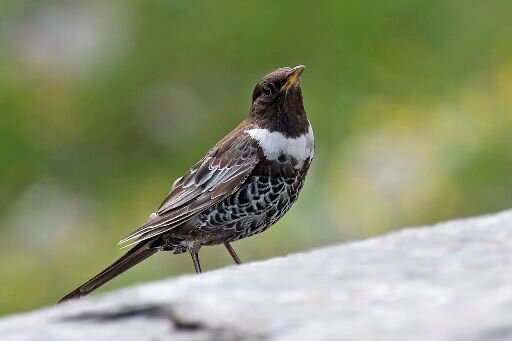Alpine Ring Ouzel
Turdus torquatus alpestris (Brehm, CL, 1831)
Photo © By Andreas Trepte - Own work, CC BY-SA 2.5, https://commons.wikimedia.org/w/index.php?curid=8256284
Sub-species
STATUS
Eurasia.
OVERVIEW
Sub-species not admitted nationally (BOU 1971).
NOT PROVEN
0). 1893 Yorkshire Kilnsea, two, adult males, seen, one obtained, 25th February.
(J. Cordeaux, Zoologist 1895: 56-57).
[Hartert et al., 1912].
History J. Cordeaux (1895) in The Zoologist, 3rd series, Vol. XIX. pp. 56-57, says: 'On February 25th, 1893, Mr. Hewetson, of Leeds, and I saw two apparently adult males near the coastguard station of Kilnsea; these, both on the ground and when in flight, showed much more white on the wings and flank than the ordinary and common type which occurs on the east coast of Yorkshire so regularly on migration in the autumn. Subsequently one was obtained in the same neighbourhood, which I saw; this was unquestionably referable to the form distinguished as Turdus alpestris by C. L. Brehm, which inhabits the alpine regions of Central and Southern Europe.'
Hartert et al. (1912: 78) say: 'One said to have been of this form obtained in Yorks. early in 1893.'
0). 1894 Norfolk Cley-next-the-Sea, female, shot, 18th September.
(J. H. Gurney, jun., Zoologist 1895: 99).
[Hartert et al., 1912; B. B. Riviere, British Birds 16: 135].
History J. H. Gurney, jun., of Norwich (1895) in The Zoologist, 3rd series, Vol. XIX. p. 99, says: 'September 18th. A female Alpine Ring Ouzel was shot on the beach at Cley by Mr. T. E. Gunn, answering the description of Turdus alpestris in Dresser's Birds of Europe, where there are four figures given of this southern variety (Vol. II. p. 113; supp. p. 653).'
Hartert et al. (1912: 78) say: 'One said to have been of this form obtained in Yorks. early in 1893, and another in Norfolk Sept. 18, 1894.'
B. B. Riviere (1922) in British Birds, Vol. XVI. p. 135, says: 'Having recently had the opportunity of examining the supposed Alpine Ring Ouzel (Turdus torquatus alpestris) in the collection of Mr. T. E. Gunn, which was obtained in Norfolk on September 18th, 1894 (Zool., 1895, pp. 56, 99), I came to the conclusion that it had been wrongly identified. I have now been able, through the kindness of Mr. Ernest Gunn, to show this bird to Dr. C. B. Ticehurst, who agrees with me that it is merely an example of Turdus torquatus torquatus.'
Comment Misidentified. Not acceptable.
0). 1911 Sussex Guestling, adult male, shot, 23rd May, now at Leicester Arts & Museums (Acc. No. L.Z162.1969.298.0).
(M. J. Nicoll, British Birds 5: 72-73, photo; W. R. Ogilvie-Grant, Bulletin of the British Ornithologists' Club 30: 186; Walpole-Bond, 1938; A. H. J. Harrop, British Birds 111: 228-230).
[E. M. Nicholson & I. J. Ferguson-Lees, British Birds 55: 299-384 HR].
History M. J. Nicoll (1911) in British Birds, Vol. V. pp. 72-73, says: 'On May 23rd, 1911, an adult male Ring Ouzel was shot at Guestling in Sussex, and shown to me while in the flesh as a "strange-looking Ring Ouzel". The bird was quite fresh and in perfect plumage, and it had such a generally whiter appearance than the common Turdus torquatus torquatus, that I at once suspected it to belong to either the "alpine" or the "oriental" form. In comparing this specimen with skins in the British Museum, I came to the conclusion that it was an undoubted example of the Alpine subspecies Turdus torquatus alpestris, and as such it is an interesting addition to the British avifauna. This handsome Ring Ouzel differs from the typical T. t. torquatus in having more white on the outer webs of the secondaries, and large white centres to the feathers of the flanks and breast. The under tail-coverts are also broadly streaked with white. The form from further east, T. t. orientalis, of which I have an adult male from Egypt before me as I write, is intermediate between the typical and Alpine forms - that is to say, the secondaries are whiter on the outer webs than are those of T. t. torquatus, but not so noticeable as in T. t. alpestris, the under tail-coverts are as broadly streaked with white as are those of T. t. alpestris, but the centres of the breast and flank-feathers are only slightly marked with white; in T. t. torquatus the feathers of the under-parts are only margined with white, and the under tail-coverts have the shafts only white. In T. t. alpestris the white edges of the feathers of the under-parts are very noticeable, far more so than in either of the other two races. Turdus torquatus alpestris has a wide range. Roughly speaking it extends, as a breeding bird, throughout middle and south Europe to the Balkans. The occurrence of this form, for the first time on record in Great Britain, is scarcely surprising. It is possible that it has occurred before and been passed over as a Common Ring-Ouzel.'
W. R. Ogilvie-Grant, Editor (1912) in the Bulletin of the British Ornithologists' Club, Vol. XXX. p. 186, on the unexpected occurrences for 1911, says: 'Male shot at Guestling (Sussex), May 23rd.'
Accepted locally (Walpole-Bond 1938 (2): 77).
Comment Hastings rarity. Not acceptable.
0). 1913 Sussex Warren Farm, near Brighton, female, shot, 29th March.
(W. R. Ogilvie-Grant, Bulletin of the British Ornithologists' Club 34: 179).
[E. M. Nicholson & I. J. Ferguson-Lees, British Birds 55: 299-384 HR].
History W. R. Ogilvie-Grant, Editor (1914) in the Bulletin of the British Ornithologists' Club, Vol. XXXIV. p. 179, on the unexpected occurrences for 1913, says: 'Female shot, near Brighton (Sussex), March 29th.'
Locally, Walpole-Bond (1938 (2): 77) adds: 'Our second example was obtained at Warren Farm, near Brighton.'
Comment Hastings rarity. Not acceptable.
